 Image search results - "japanese" Image search results - "japanese" |

About Genova ジェノバの紹介Genova (or Genoa) is a port city on the west coast of Italy. It is the birthplace of Christopher Columbus. For 2004, it was designated as the European City of Culture. From Milan, it takes about 90 min. to reach Genova.
ジェノバは、イタリアの北の西海岸にある港街です。コロンブスの出身地でもあります。ミラノから電車で約1.5時間かかります。
|
|

Sugawara house from Tsuruoka city, Yamagata Prefecture. In heavy snow, the front window was used as the door.
|
|

Ceiling
|
|

Kitamura house brought from Hadano, Kanagawa
|
|

Kitamura house
|
|

Nihon Minkaen is an outdoor museum of traditional farm and merchant houses with thatched roofs. They have 25 homes from around Japan many were donated to the museum for preservation.
|
|
|
|

Thatched roof
|
|

Water nozzles aimed at the house. No smoking.
|
|
|
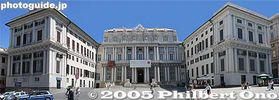
Palazzo Ducale, site of the Japan art exhibition in 2005 (Giappone - L'Arte del mutamento). (展覧会の会場)From April to Aug. 2005, a huge Japanese art exhibition was held at this former palace. It exhibited ukiyoe, posters, textiles, and photographs. The photo exhibition, curated by Rossella Menegazzo and myself (Philbert Ono), showed images of the Hiroshima and Nagasaki atomic bomb aftermath.
2005年4月〜8月にイタリアのジェノバ市で日本の美術展覧会が開催され、浮世絵、着物、アートポスターと写真が展示されました。 写真展は、60周年のため広島・長崎原爆関係の写真が紹介されました。会場は、立派なドゥカーレ宮殿でした。
|
|
|
|
|

Yamada house
|
|
|

Information Center きよせカタクリまつり
|
|
|

A short walk from the Information Center is Area C (C-chiku), a flat area of woods with katakuri flowers in bloom. C地区
|
|

Emukai house brought from Nanto, Toyama. In the gasshi-zukuri style with steep roof. Kawasaki Nihon Minkaen
|
|

They even provide a small deck for you to stand on to see the flowers. C地区
|
|

Nihon Minkaen, Kawasaki, Kanagawa
|
|

Among the trees and grass, you can see the small purple flowers. C地区
|
|

Inside Emukai house
|
|

It is getting rarer to see these flowers in Tokyo. Kiyose has an active movement to help preserve and nuture these flowers every year.
|
|
|

Japanese dog's tooth violet (katakuri or Erythronium japonicum)
|
|
|
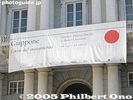
Close-up of sign above the entrance to Palazzo Ducale
|
|

Entrance to Koishikawa Korakuen Garden. It opened as a public garden in 1938. The garden is modeled after Chinese concepts and features.Near Iiidabashi Station and Korakuen Station.
|
|

Japanese dog's tooth violet (katakuri or Erythronium japonicum)
|
|
|

Ticket office at Koishikawa Korakuen Garden. Admission ¥300. Free English pamphlet/map available.
|
|

The flower is a member of the lily family, not really a violet.
|
|
|

Map of garden. Koishikawa Korakuen Garden is designated as one of Japan's Special Historic Place and Special Scenic Spot. Only select places in Japan (like Kyoto's Kinkakuji) have both designations. 国の特別史跡・特別名勝
|
|

A short walk away is Area B which is a wooded slope with the flowers growing wild. B地区
|
|
|

Weeping cherry tree
|
|

Tiny purple flowers on the slope
|
|

Nihon Minkaen, Kawasaki, Kanagawa
|
|

Weeping cherry tree, Koishikawa Korakuen Garden, Tokyo. 枝垂桜
|
|
|

Toilet
|
|

This weeping cherry tree is about 60 years old.
|
|
|

The museum park has 25 homes from around Japan many were donated to the museum for preservation. Near Mukogaoka-yuen Station on the Odakyu Line. Closed Mon. Admission 500 yen.
|
|

Weeping cherry tree, Koishikawa Korakuen Garden, Tokyo.
|
|

Dog's tooth violet on a slope
|
|

Water mill
|
|

Weeping cherry tree, Koishikawa Korakuen Garden, Tokyo. Called "Shidare-sakura" in Japanese meaning cherry tree with drooping branches.
|
|

Top view of Japanese dog's tooth violet (katakuri or Erythronium japonicum). The petals are flared back (or upward).
|
|

Inside water mill
|
|

With Tokyo Dome looming above, Koishikawa Korakuen is another famous Edo-Period Japanese garden originally built by Lord Yorifusa of the Mito Tokugawa Clan in 1629 as part of his Edo estate.The garden was completed under Lord Mitsukuni, the second lord of the Mito clan.
|
|

Japanese dog's tooth violet (katakuri or Erythronium japonicum), Kiyose, Tokyo カタクリ
|
|

Hydrangea
|
|
|
|

Japanese dog's tooth violet on a slope.
|
|
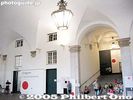
Inside the Palazzo DucaleAs soon as you enter, this is what you see. The lower left is the entrance to the bookstore, and the stairs go up to the textile and ukiyoe exhibition.
|
|
|

Front (or bottom) view of the flower. Japanese dog's tooth violet (katakuri or Erythronium japonicum)
|
|

Shorozan hill 小廬山
|
|

Japanese dog's tooth violet (katakuri or Erythronium japonicum)
|
|
|

Japanese dog's tooth violet (katakuri or Erythronium japonicum)
|
|

Tokyo Dome in the background. The garden is right next to Tokyo Dome.
|
|

Poster for the Katakuri Festival
|
|
|

Larger weeping cherry tree.
|
|

Area A next to the river. A地区
|
|
|

Area A next to the river.
|
|
|
|

Weeping cherry tree, Koishikawa Korakuen Garden, Tokyo.
|
|

Weeping cherries
|
|
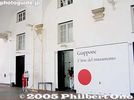
Museum shop entrance and tanabata display.This was taken on July 9, 2005 which is close to Tanabata.
|
|

Weeping cherry tree and Tsutenkyo Bridge 通天橋
|
|

Tsutenkyo Bridge 通天橋
|
|

Large weeping cherry tree しだれ桜
|
|
|

Folding screen (byobu) rock 屏風岩
|
|

Tsutenkyo Bridge 通天橋
|
|

View from Tsutenkyo Bridge 通天橋
|
|
|

Tokujindo Hall which stores wooden statues from old Chinese stories. 得仁堂
|
|

Koishikawa Korakuen Garden has a circular design around a pond and low hill. 回遊式庭園
|
|

Entrance to Hiroshima-Nagasaki photo exhibition 広島・長崎原爆写真展の入口
|
|

Picnic area
|
|
|
|

Cherry trees line the Osensui pond. 大泉水
|
|

In the background is Horaijima island (not accessible). 蓬莱島
|
|

Shiraito Waterfall. Nothing spectacular. 白糸の滝
|
|

Iris bed. Should come back in June.
|
|

Colorful flowers break the monotony of greenery. ハナモモ
|
|

Ornamental peaches (Hanamomo in Japanese) ハナモモ
|
|

White ornamental peaches (Hanamomo in Japanese) look like cotton on branches. ハナモモ
|
|

White ornamental peaches ハナモモ
|
|
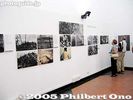
Hiroshima photos 広島原爆写真
|
|

Hiroshima panorama photos by Shigeo HayashiThe exhibition room was divided in half by this panel. The right side was for Hiroshima, and the left side for Nagasaki.
|
|
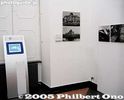
Video monitor showing Hiroshima
|
|
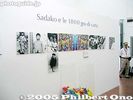
Sadako and her origami cranesBased on a story of a girl named Sadako who was exposed to the atomic bomb in Hiroshima. She was told that if she folded 1,000 paper origami cranes, she would be granted a wish. But she died at age 12 even after folding over 1,000 paper cranes.
|
|

Eight-plank Bridge 八つ橋
|
|

Engetsukyo Bridge (Full Moon Bridge) 円月橋
|
|

Stone bridge steps 円月橋
|
|

Engetsukyo Bridge (Full Moon Bridge) so named because it creates full moon with its reflection in the water. 円月橋
|
|

Nagasaki photos by Yosuke Yamahata 山端庸介が原爆投下翌日の写真を撮ったYosuke Yamahata was an Imperial Army photographer who was ordered to go to Nagasaki to photograph the after effects of the atomic bomb. He and two others, a writer and an artist, arrived in Nagasaki the morning after the bomb was dropped. Yamahata went on to capture over 100 extraordinary images of the devastation, people who survived, people helping the wounded, and the inevitable corpses.
山端庸介(1917−66)は陸軍報道カメラマンとして原爆投下翌日の長崎に入り,100枚以上の非常に貴重な歴史的の写真を撮った。長崎原爆資料館にも大きく展示されている。
|
|

Kuhachi-ya 九八屋
|
|

Naitei Inner Garden, formerly a private garden for a guesthouse built by the Mito Clan. The garden just does not match the huge Tokyo Dome in the background... 内庭
|
|

Picnickers
|
|

Shaved ice (kakigori) with fruits
|
|

Outside wall of garden.
|
|

The outside wall also uses stones from the Sotobori Moat of Edo Castle.
|
|
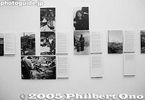
Nagasaki photos by Yosuke Yamahata. 写っている人物の当時の状況が詳しく語っています。In 1995, NHK, Japan's leadning TV station, successfully identified some of the survivors pictured in Yamahata's photographs. They even interviewed some of them who were still living. They aired a special TV program and published a book about the extraordinary stories of the survivors.
Those stories have been summarized into Italian for the photo captions in this exhibition.
写っている人物の当時の状況が詳しく語っています。10年前にNHKの取材班が山端庸介の原爆写真に写っている人物の名前とか所在を調べてまだ生きている何人かとインタービューが成功。それが、テレビ番組と本「NHKスペシャル 長崎 よみがえる原爆写真」になって大変感動しました。(テレビ番組も昨年8月に再放送された。)
そのNHK Special番組と本を参考してこの新しい写真集の写真説明文を書きました。イタリア語になっていますが、それぞれの写真を今まで外国語で詳しく説明されたことないのです。被爆者の感動的の話しをもっと海外にも伝いたいのです。
|
|

Nagasaki photos by Yosuke Yamahata
|
|
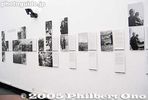
Nagasaki photos by Yosuke Yamahata
|
|

Nagasaki photos and origami corner 折り紙コーナーVisitors were encouraged to fold a paper crane.
|
|
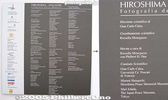
Panel for exhibition credits クレジットRossella Menegazzo and Philbert Ono were co-curators of the photo exhibition.
イタリア側でこの展覧会と図録のコーディネートをしているRossella Menegazzoさんは、ちょっと古い友人です。彼女は素晴らしい頑張りやさん。まだベネチア大学の学生のとき、夏休みに来日して僕と会いたいと言われて都内のピザ屋(彼女のバイト先)で初めて会ってあげた。
「卒業論文のため、日本人の写真家を研究したい!」と言い出してびっくりしたよ。「木村伊兵衛か土門拳、どっちがいいと思う?」と聞かれても答えないよ。(結局、土門拳になった。)しかし、参考書はほとんど日本語で英語の参考書も(僕のHP以外)非常に少ないと指摘した。でも3年後、なんとイタリア語で土門拳の論文が完成された。これは、イタリア国内で史上初の日本人写真家の論文である。ということは、彼女が日本語も勉強して読めるようになったの。凄いでしょう。
で、話しがまだ続く。彼女の草分けの論文のおかげで大学の後輩も二人、三人が日本の写真家の論文を書いたりしているの。その後輩たちにも僕ができる限り参考書など送っています。(向こうは喜ぶね。)でも、その学生さんが日本人の写真家を論文のためにインタービューしようとすると拒否されることがある(例えば奈良原 一高)。それを聞くと僕はとても恥ずかしい気持した。一方、森山大道の論文を書いた学生が本人とのインタービューが成功した。彼女がとても喜んでいたそうです。(大道さん、ありがとう。)
|
|

Nagasaki exhibition catalog: Yosuke Yamahata-Nagasaki 山端庸介の新しい写真集兼図録This book shows all of Yosuke Yamahata's photos of Nagasaki, including the the 100+ photos of Nagasaki taken on the day after the bomb was dropped. The book includes a photo which has never been published in a book. Many detailed captions about the people identified in the photos are also included. Language is Italian. Order from PhotoGuide Japan's iStore.
山端庸介(1917−66)は陸軍報道カメラマンとして原爆投下翌日の長崎に入り,100枚以上の非常に貴重な歴史的の写真を撮った。長崎原爆資料館にも大きく展示されている。
過去に山端庸介の写真集が国内外に出版されたことあるけど、撮った写真の一部しか紹介されていませんでした。今回の新しい写真集は、山端庸介の長崎関係の全集の写真集とも言えます。本に出版されたことない写真もあります。1946年に撮った写真もあります。
そしてもう一つの大きな特徴は、説明文。写っている人物の当時の状況が結構詳しく語っています。10年前にNHKの取材班が山端庸介の原爆写真に写っている人物の名前とか所在を調べてまだ生きている何人かとインタービューが成功。それが、テレビ番組と本「NHKスペシャル 長崎 よみがえる原爆写真」になって大変感動しました。(テレビ番組も昨年8月に再放送された。)
そのNHK Special番組と本を参考してこの新しい写真集の写真説明文を書きました。イタリア語になっていますが、それぞれの写真を今まで外国語で詳しく説明されたことないのです。被爆者の感動的の話しをもっと海外にも伝いたいのです。
|
|
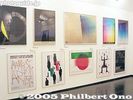
Poster exhibition 日本のポスター展In the huge, cavernous basement of the Palazzo Ducale, over 600 artistic Japanese posters were on display.
地下の凄い大きいホールになんと600枚のポスターが展示。
|
|

Poster exhibition
|
|

Poster exhibition
|
|

Poster exhibitionA few expo posters. Even those poster designs which were not selected to be the official poster design were included in this exhibition.
|
|

Yokosuka curry
|
|
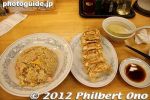
Cha-han fried rice and gyoza
|
|
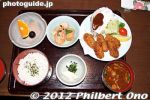
Fried oysters in Hiroshima.
|
|
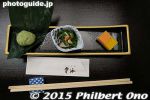
Appetizer, Kyoto
|
|
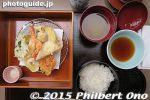
Tempura
|
|

Kaki-fry teishoku or fried oysters
|
|

Shabu-shabu dinner with the shabu-shabu pot having a divider so we can try two different flavored broths.
|
|

Sukiyaki dinner
|
|
|
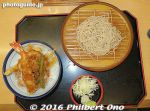
Small tempura donburi and cold soba noodles at Tenya
|
|
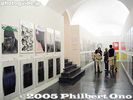
Poster exhibition
|
|

Poster exhibition
|
|

Poster exhibition catalog: Manifesti D'Artista 1955-2005 ポスター展の図録All 600 posters featured in the exhibition is reprinted in this thick catalog called "Manifesti D'Artista 1955-2005," published by Ideart. Language is Italian. Order from PhotoGuide Japan's iStore.
|
|
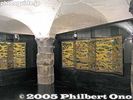
Folding screen 屏風も
|
|

Upstairs to the textile and ukiyoe exhibitions 二階へ二階に織物展と浮世絵展が開催。
|
|
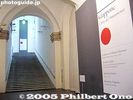
Upstairs to the textile and ukiyoe exhibitions 二階へ
|
|

Textile exhibition 織物展The textiles were exhibited in the best rooms of the Palazzo Ducale, including the chapel shown here. Beautiful frescoes decorated the walls and ceilings. What a contrast it was between the Japanese kimono and religious motif.
織物は宮殿の一番豪華な多数の部屋に展示された。
|
|

Textile exhibition 織物展The textiles included kimono, noren curtains, and stenciled works.
着物、のれんなど展示された。
|
|

Textile exhibition catalog: Avvolti Nel Mito 織物展図録The textiles exhibited are shown in this catalog called "Avvolti Nel Mito" (Wrapped in the Myth) published by Ideart. Language is Italian. Order from PhotoGuide Japan's iStore.
|
|
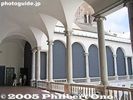
Entrance to ukiyoe exhibitionThis is the second floor (in Italy, it's called the first floor). And what we in Japan and the US call the 1st floor is the zero floor in Italy.
|
|

Entrance to ukiyoe exhibition 浮世絵展の入口
|
|

Entrance to ukiyoe exhibition 浮世絵展の入口
|
|

Ukiyoe exhibition 浮世絵展The ukiyoe collection came from the Chiossone Museum in Genova. The collection was amassed by Genova native and printing expert Edoardo Chiossone (1833-98 who was dispatched to Japan in 1875 to help Japan modernize its printing technologies (for printing money, etc.). During his 23 years in Japan, he acquired thousands of Japanese art works, especially ukiyoe which numbers 4,000 works. He never returned to Italy and died in Japan.
ジェノバ出身の彫刻師エドアルド・キヨッソーネ(1833-98)は、1875年大蔵省紙幣寮(のちの内閣印刷局)の求めに応じて来日。当時、日本の近代化を推進していた明治政府は外国から優れた技術者を「お雇い外国人」として招いており、キヨッソーネもその一人でした。日本近代印刷技術の礎を築きます。
キヨッソーネの日本滞在は24年にわたり、ついに祖国イタリアへ戻ることなく日本で生涯を終えますが、その間に日本美術に触発され約15,000点余りの美術品を収集するに至ります。なかでも浮世絵のコレクションは4,000点におよび、コレクションのなかでも最も充実したジャンルを形成し世界有数の浮世絵コレクションとして知られています。現在はジェノバ市立キヨッソーネ東洋美術館が所蔵されています。
|
|

Ukiyoe exhibition
|
|
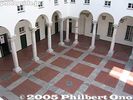
Palazzo Ducale courtyard
|
|
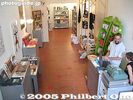
Ideart bookstore 図録の出版社であるIdeartの会場内売店(展示期間のみ)At the end of the poster exhibition hall, you enter this bookstore where you can buy all the exhibition catalogs, Japanese books (in Italian), and other neat things. This Ideart (publisher of the exhibition catalogs) bookstore operated only during this exhbition.
|
|
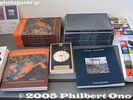
Exhibition catalogs 図録Order from PhotoGuide Japan's iStore.
|
|
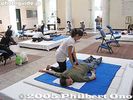
Shiatsu demonstrationThe other courtyard of the Palazzo Ducale had shiatsu demonstrations when we were there in July. During the exhibition, various Japan-related events and demonstrations were held such as taiko drumming and martial arts.
|
|
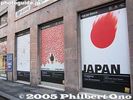
Posters at Genova Fnac Bookstore 市内のFnac本屋でPRThe Fnac Bookstore was generous enough to provide space on their outdoor walls to publicize the exhibition with replicas of the posters and photos.
フランスに本社がある大手本屋さんのFnacのジェノバ店で今回の展覧会をPRするために展覧会関係の巨大ポスターを店の壁に張ってくれました。
|
|

Posters at Genova Fnac Bookstore
|
|

Posters at Genova Fnac BookstoreShot of bombed Nagasaki above one entrance.
山端庸介の長崎原爆写真も入口の上に。
|
|

Ukiyoe at Genova Fnac BookstoreUkiyoe decorates the bookstore facing the main street.
|
|

Reception table backed by a board listing various corporate sponsors. I attended the final show on Oct. 29, 2008 at 3 pm.
|
|

Stairway to the hall.
|
|

A side attraction was a tea session (ocha-seki) performed and served by two geisha (or hangyoku). It cost 700 yen for tea and sweets. お茶席
|
|

Hall lobby (Get that trash bin outta there.)
|
|

The 2nd floor had a booth selling Asakusa geisha souvenirs. The dance program was 1,000 yen.
|
|

A hand towel with the names of all the current Asakusa geisha was selling for 1,500 yen. They also had T-shirts.
|
|

Name cards of all the geisha were sold for 100 yen apiece.
|
|

Name cards of all 49 Asakusa geisha.
|
|

The dance consisted of four numbers. The first one was called Sara Sanban-so (晒三番叟) which was first performed in Edo in Nov. 1755. 宝暦5年
|
|
|
|
|
|
|
|
|
|
|

There were only four dancers, but they went through several costume changes onstage.
|
|
|
|
|
|
|
|
|
|
|
|
|
|
|
|
|

Waving these white streamers created a dazzling visual effect. It must have been either the wind or river.
|
|
|
|
|

For the second number, there was a little stage for the musicians and singers on the right of the stage.
|
|
|

The second number was called Matsuri (Festival). It featured these three young village girls and two geisha dancers. 藤間流 まつり
|
|
|
|
|
|
|
|
|
|
|
|
|
|
|
|
|
|
|
|
|
|
|

The third number was called 三枚続花の姿絵 and consisted of three parts. The first part was called 星月夜 which means "Night of Stars and Moon."
|
|
|

These six geisha dressed as young maidens make their first-time appearance in the Asakusa Odori.
|
|
|
|
|

With a dark background, the geisha seemed to glow in the dark.
|
|
|
|
|
|
|
|
|
|
|
|

Sank into the stage to disappear.
|
|

The second part of 三枚続花の姿絵 was called Hagi no Hanazuma 萩の花妻 which means Bush Clover Flower Lady.
|
|

A more mature woman appears for this part set in autumn.
|
|
|
|

She left the stage this way.
|
|

The third part of 三枚続花の姿絵 was called Hana no Shojo 花の猩々 which means Flowery Heavy Drinker. This play comes from a Noh play.
|
|

The play is set during the cherry blossom season.
|
|
|
|

Three red-haired lions.
|
|
|
|
|
|
|
|
|

Drinking sake
|
|
|
|
|
|
|
|

The three red lions were nice, but they didn't swing their hair round and round like in kabuki.
|
|
|
|
|

On the hanamichi
|
|
|

Then there was a 20-min. intermission which featured a comedic trio.
|
|

I took the intermission time to photograph an Asakusa geisha.
|
|

Lobby
|
|

The fourth and final number was the Finale called 江戸の心浅茅の賑い which consisted of six parts. They performed their zashiki dances.
|
|

The Finale's first part was called Namiki Komagata-Koi no Asakusa 並木駒形 恋の浅草
|
|
| 1358 files on 6 page(s) |
1 |
 |
 |
 |
|